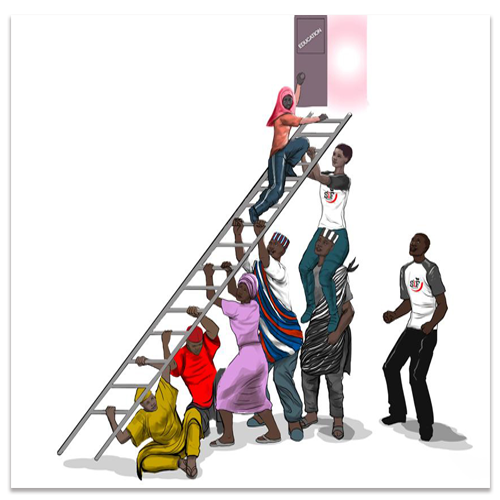Female Genital Mutilation (FGM) has no health benefits, and it harms girls and women in many ways.
FGM means non-therapeutic, partial, or complete removal or injury of each of the external female genitals. Four types of FGM are distinguished: type I stands for the removal of the clitoral foreskin, type II means the removal of the clitoris with partial or total excision of the labia minora. Type III is the extreme type of FGM. Not only the clitoris but also the labia minora and majora were removed. The orificium vaginae is sewn up, leaving only a small opening for urine or menstruation blood. Other types like pricking, piercing of clitoris or vulva, scraping of the vagina, etc. were defined as type IV of FGM. The mentioned reasons for FGM are: encouragement of the patriarchal family system, method for birth control, guarantee of moral behaviour and faithfulness to the husband, protection of women from suspicions and disgrace, initiation ritual, symbol of feminity and beauty, hygienic, health and economic advantages [2].
No health benefits, only harm
FGM has no health benefits, and it harms girls and women in many ways. It involves removing and damaging healthy and normal female genital tissue, and interferes with the natural functions of girls’ and women’s bodies. Generally speaking, risks of FGM increase with increasing severity (which here corresponds to the amount of tissue damaged), although all forms of FGM are associated with increased health risk.
Immediate complications can include:
- severe pain
- excessive bleeding (haemorrhage)
- genital tissue swelling
- fever
- infections e.g., tetanus
- urinary problems
- wound healing problems
- injury to surrounding genital tissue
- shock
Long-term complications can include:
- urinary problems (painful urination, urinary tract infections);
- vaginal problems (discharge, itching, bacterial vaginosis and other infections);
- menstrual problems (painful menstruations, difficulty in passing menstrual blood, etc.);
- scar tissue and keloid;
- sexual problems (pain during intercourse, decreased satisfaction, etc.);
- increased risk of childbirth complications (difficult delivery, excessive bleeding, caesarean section, need to resuscitate the baby, etc.) and newborn deaths;
- need for later surgeries: for example, the sealing or narrowing of the vaginal opening (Type 3) may lead to the practice of cutting open the sealed vagina later to allow for sexual intercourse and childbirth (deinfibulation). Sometimes genital tissue is stitched again several times, including after childbirth, hence the woman goes through repeated opening and closing procedures, further increasing both immediate and long-term risks;
- psychological problems (depression, anxiety, post-traumatic stress disorder, low self-esteem, etc.);
FGM carried out by doctors, nurses or midwives is also called medicalization of FGM and is definitely unacceptable. Regarding human rights, FGM refuses women the right of freedom from bodily harm. Specific laws that ban FGM exist in many countries in Europe, Africa, USA, Canada, New Zealand and Australia.
FGM is still a violation against human right and we call on all necessary authorities, governments, NGOs and concerned citizens to join the fight against FGM.
Disclaimer:
This piece is curated by Eghosasere Egbon Gabriel through reading from the following:
- U. U. UNICEF, “Female genital mutilation fact sheet,” WHO-International/Reproductive Heal., 2014.
- Utz-Billing and H. Kentenich, “Female genital mutilation: An injury, physical and mental harm,” Journal of Psychosomatic Obstetrics and Gynecology. 2008, doi: 10.1080/01674820802547087.




